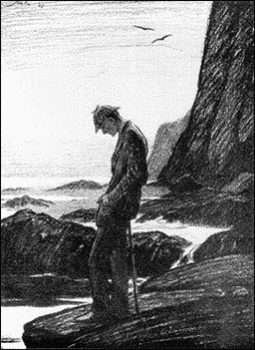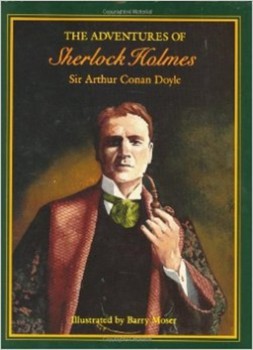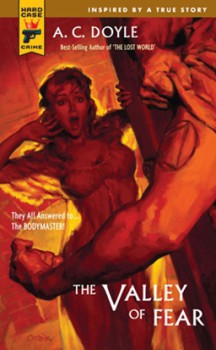The Public Life of Sherlock Holmes: What Story Should You Read First?

Recently a post in a Holmes Facebook group caught my eye. A woman was a fan of one of the current TV shows (I don’t recall if it was Elementary or BBC’s Sherlock), but she loved it and wanted to read the stories. She wondered where to start.
First, I think it’s a bit interesting that there are Holmes fans that have never read Sir Arthur Conan Doyle’s stories. They only know the detective through television shows set in the modern day. I suppose this also happened a bit with the first Robert Downey Jr. movie, but that had a shorter shelf life. Anyhoo…
There’s a bit of a divide in the Holmes community these days between the ‘old school’ and the newer generation. One characterization is between those who study the stories and those who write speculative fan fiction that has little to no relationship with Doyle’s actual writings. To some extent, there’s always been an old guard/new fans distinction, but social media has exploded it.
While I’ve long been a fan of Holmes pastiches and enjoy most movies and films, I do look askance at all the doey-eyed swooning over Benedict Cumberbatch as Holmes. And they’ll pry my calabash pipe from my cold, dead hands before I recognize merit in this Sherlock Meta stuff.
But moving off the grumpy old man ruminations, the question the woman asked was a good one. The initial responses seemed to go with the standard ‘read them in the order they were written.’ That’s logical. But I don’t think it’s the best way to go.
Doyle wrote fifty-six short stories and four novellas featuring Holmes. The stories do not occur in chronological order, which was not unusual in that era, but has certainly become the standard for fantasy and mystery authors of our time. Now, I wouldn’t read “The Empty House” before “The Final Problem,” but otherwise, you can pretty much pick and choose as you like.
So, why start where? Or, why not read them in order? Because, to entice a new reader to stick with Holmes, the first story is not among the best of the sixty, that’s why.

As I discussed in an earlier post, with an almost non-existent medical practice on his hands, Doyle had some spare time and wrote A Study in Scarlet. Readers were introduced to the world’s first private consulting detective. Actually, very few people were. The story made no splash at all. An American magazine editor commissioned a second Holmes tale and Doyle dutifully dashed off The Sign of Four. Two long form stories and Holmes had quietly come and gone.
Then, The Strand Magazine provided an opportunity to turn Holmes into a short story star. Six, then six more stories became sensations, The Adventures of Sherlock Holmes was published and the rest is history.
At some point, I’m going to write a post on Holmes’ inability to carry a novella. He is absent for significant portions of all four of Doyle’s books, and Watson in three of them.
In A Study In Scarlet, there is a LONG flashback, set in Mormon country, which has nothing to do with Holmes and Watson. There are a few more pages of recap in which Holmes and Watson are barely more than passive observers. In all, about 43% of this novella does not include the pair.
Now, story-wise, it’s not bad. I don’t think Study is one of the best, nor one of the worst, Holmes tales. But an average story, almost half of which doesn’t include Holmes or Watson…I don’t suggest that someone new to Holmes start with A Study in Scarlet. It’s not the strongest opening move to make a life-long fan.
It’s Elementary – A Study in Scarlet was originally to be titled The Tangled Skein, which comes from a line in the story.
The Sign of Four, the second story and novella, is, I think, a much better read. As far as “off-stage” time goes, this one fares much better. At the conclusion of the story, there is again a long expository sequence that goes back in time. Holmes and Watson listen. Now, in this instance, the recapping takes up about 19% of the book. It is a bit of a break, but mystery stories in which the villain (or the protagonist, in the case of a Nero Wolfe tale) finishes things up by expounding upon the case, is not uncommon: then or now.

But it does shift the reader’s focus from Holmes and Watson after an exciting climax. Regardless, Sign is better than Study and makes a more suitable first read in almost every way (Study does include the first meeting between Holmes and Watson, but that can be read later).
Many people cite The Hound of the Baskervilles as their favorite Holmes story (I’m a big fan as well. It’s a bit of a gothic mystery). And I don’t think it would be a bad first read to capture the new reader’s interest. In publication order, it’s the twenty-fifth published, so Doyle certainly knew what he was doing at that point. It’s also the longest, but compared to modern book lengths, that’s not daunting.
In a departure from the two prior novellas, there is no lengthy flashback (though there is a short one at the start) and Watson is present throughout the story. Holmes, however, is gone for about 41% of it. Because you’ve got ongoing action and Watson on the case the whole way, this is a better Holmes and Watson “vehicle” if you will. And starting with this atmosphere-filled novella is almost guaranteed to bring the new reader back for a second tale. Which I would suggest to be “A Scandal in Bohemia” and the rest of The Adventures.
We might as well touch on the fourth and final novella while we’re in the neighborhood. The Valley of Fear is the only Holmes tale to approach what would become the hardboiled school. In this case, the American flashback comprises almost fully half of the book! So, again, Holmes and Watson take much of the book off. Although, with its Dashiell Hammet-like feel, the story of the Scowrers mostly makes up for the lack of Holmes. It’s a good story, but there’s no real reason to make it your first read.
So, Bob, where does that leave a newbie to the Canon? Good question: musta got lost (J. Geils Band reference. Anyone???). If I were starting over and knew what I know now (what?), I’d read all twelve of The Adventures of Sherlock Holmes. Then I’d go back and read A Study in Scarlet and The Sign of Four. Then I’d pick go back to the short stories with The Memoirs of Sherlock Holmes.
Because of the Holmes absences (and the overall lesser quality of Study), I think a new reader is more likely to enjoy The Adventures. I would expect that person to be hooked on Holmes by the end of them. Probably even by the end of the sixth story. The imperfections of Study and the longer reading time required by it and Sign aren’t as likely to turn off a new reader if they’ve gone through The Adventures.
I could also see reading The Hound of the Baskervilles, which is again likely to win the first time reader over, first, then repeating the method just mentioned, or even starting with Study and Sign (perhaps they enjoy the longer form story), then hitting The Adventures.
Because of the quality of The Adventures (“A Scandal in Bohemia,” “The Red Headed League” and “The Speckled Band” should be in everybody’s top ten and a few others are solid candidates), it doesn’t make sense to me to start with any of the other collections. There’s no real gain by skipping ahead. And you could start with Sign and then The Adventures, but you’d probably want to go back and read Study next.
I don’t think it’s vitally important which story you read for your first venture into Sherlock Holmes’ London. But I do believe that The Adventures are a much better introduction to Holmes than A Study in Scarlet. And if the new reader isn’t already committed to continued reading of the stories, that’s the way to go.
This is my first Holmes-related post in over a month. And I had to tear myself away from Terry Pratchett as I’m finishing up my second City Watch book re-read since last week’s post. Pratchett’s Discworld truly is a treasure.
You can read Bob Byrne’s ‘The Public Life of Sherlock Holmes’ column here at Black Gate every Monday morning.
He founded www.SolarPons.com, the only website dedicated to the ‘Sherlock Holmes of Praed Street’ and blogs about Holmes and other mystery matters at Almost Holmes.
I introduce college students to Sherlock Holmes with “The Speckled Band.” It’s atmospheric and shows the great detective to advantage, not only as an observer but as a sensitive person. (He catches Helen covering up her stepfather’s physical abuse of her.) The scene in which Roylott bursts in on Holmes in Holmes’s own residence, and bends the poker, is followed by the delectable surprise in which, after Roylott’s departure, Holmes bends the poker back: villain and hero are even well-matched as physical opponents. So strong is the narrative pull that first-time readers never (so far as I know) stop to ask serious questions about, e.g., how it could be that Helen never noticed, or never questioned why, her bad is bolted the floor! The story ends with a pleasantly gruesome bit of poetic justice.
I follow this up with “The Red-Headed League,” which also pairs Holmes with an interesting villain: Doyle makes something of Holmes having what Watson calls a “dual nature”: Holmes the ruthless and tireless sleuth, Holmes the aesthete at the concert; and then the villain has a dual nature, too: aristocratically-born, but thoroughly acclimated to the underworld.
Only after at least these two stories are students ready for “A Scandal in Bohemia,” which should never, never, be the first Holmes story one reads. Its impact is greatly reduced if one has not become accustomed to Holmes’s self-confidence being amply justified, as in the other stories mentioned. Read as a third (or later) story, “Scandal” is delightful as we see Doyle/Watson set Holmes up so delightfully for a fall; the great detective, who has so severely insisted that one must be guided by observation of particulars, proceeds in this one to employ a syllogisms instead:
1.I know how women behave.
2.Irene Adler is a woman.
3.Therefore I know how Irene Adler will behave (she can’t possibly outwit me).
Things would have ended embarrassingly indeed for Holmes if Irene Adler hadn’t had no reason to send the incriminating photograph. As it is, he’s mortified anyway; but his recovery pleases us.
Another story that must not be someone’s first Holmes story is “The Engineer’s Thumb,” in which the bad guys make their escape.
I’m pretty much in agreement on this, though I’d go this way: read Adventures first, in the order in the book you have. Then read Hound. Then read the rest of the short stories, saving the set with The Empty a Room for last.
If that’s insufficient to slake the Holmes thirst, and rereading is not wanted, sure, go ahead and read the other novels, which I find of lesser interest than the foregoing.
Oops, that should have been The Empty HOUSE. Sorry
Hi Major.
I don’t see the negative to starting a new reader with Scandal, which brings forth the best of Holmes right out of the gate in an exciting story (housebreaking, spurned woman, royal client, deductions at the start, etc).
I enjoy The Engineer’s Thumb, but as with The Five Orange Pips, it’s certainly not Holmes’ finest hour. Rather humbling, (I’d say.
I’d agree with starting with The Adventures as a collection. The first story I ever read was The Speckled Band, which seemed to be collected in most children’s anthologies at the time. Then I was captured by the Rathbone/Bruce films which my father lest me stay up to watch on TV. Years later, my husband told me he’d also started reading Holmes with The Speckled Band.
Violette: Doyle listed his 12 favorite Holmes stories once for The Strand Magazine. First on the list was The Speckled Band.
I discovered the Ronald Howard tv show on late night tv before I saw the Rathbone movies. I probably watched those before I started reading the stories.
[…] As I mentioned in last week’s post, Holmes is absent for significant chunks of each novella. In a post on Tom Baker’s Hound of the Baskervilles, I touched on the casting problem that creates. By keeping these cartoons at 45 minutes, it all but requires that the flashback scenes be very streamlined or eliminated altogether. Little damage is done in doing so. […]